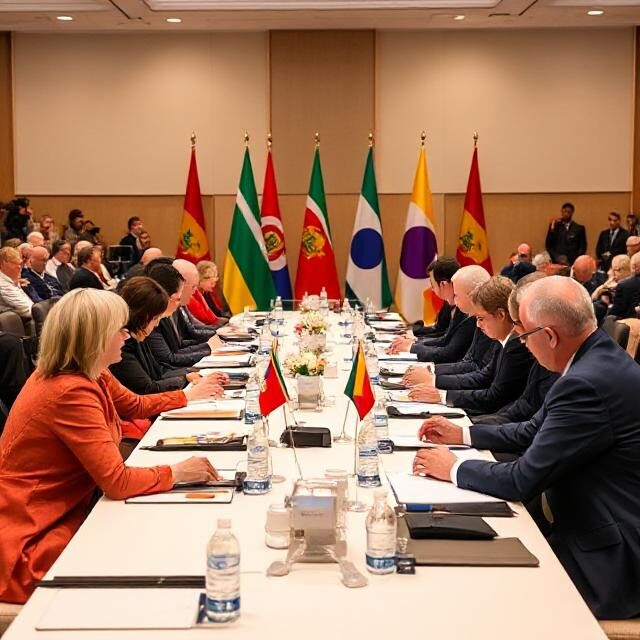As global dynamics continue to shift, the importance of countries in the Global South, such as those in Central Asia, is further elevated. This elevated importance helps explains the recent expansion of BRICS into Central Asia, and reflects the region’s growing economic and geopolitical significance. Central Asia, with its strategic location and abundant resources, has become a focal point for global powers. But how is the geopolitical landscape of Central Asia evolving as major powers like China, Russia, and the United States vie for influence.
The intergovernmental organisation known through its acronym, BRICS (Brazil, Russia, India, and China), has sought to increase the global influence of emerging economies through better economic and diplomatic coordination between members. Recently, Egypt, Ethiopia, Indonesia, Iran and the United Arab Emirates along with Kazakhstan and Uzbekistan were granted partner status. Established in Yekaterinburg, Russia in 2009, BRICS was inspired by Jim O’Neill’s thesis, which identified the founding members as emerging markets were collectively capable of surpassing any existing intergovernmental organisation. The BRICS group seeks to coordinate economic and diplomatic ties, establish new financial institutions, and decrease dependency on the US dollar. In many ways, it serves as a counterpart to the Group of Seven (G7), an organization of industrialized nations including the United States, Canada, France, Germany, Italy, Japan, and the United Kingdom.
Despite internal divisions, BRICS membership has grown from four founding members to ten member-states and with its expansion, some analysts anticipate that BRICS could surpass the influence of the current Western-led order. The bloc’s significance lies in its collective economic and demographic heft in representing over a quarter of the global economy and nearly half of the world’s population. But as BRICS expands, what are the motivations and expectations of its new partner states?
Despite often being portrayed as a monolithic entity with anti-Western sentiments, BRICS is better described as a coalition of non-Western economies seeking to create a multipolar world order. The most recent summit, held in Kazan, Russian, in late 2024, focused on a theme of ‘Strengthening Multilateralism for Fair Global Development and Security,’ in underscoring the bloc’ commitment to reforming global governance. Key outcomes included the introduction of BRICS Pay, a payment system designed to facilitate transactions and reduce dependence on Western financial systems like SWIFT. Additionally, the BRICS Kazan Declaration emphasised the need for major reform of the United Nations (UN) and endorsed the full participation of the State of Palestine in the United Nations.
The 16th summit was particularly crucial for the Central Asian region as Kazakhstan and Uzbekistan were granted BRICS partner status, with Turkmenistan participating in the BRICS Plus/ Outreach Program for the first time. The 2024 summit officially accepted a total of 13 countries as partners, including Algeria, Belarus, Bolivia, Cuba, Indonesia, Malaysia, Nigeria, Thailand, Türkiye, Uganda, and Vietnam.
Although granted partner status, Kazakhstan refrained from joining the BRICS as a full member; a decision that aligns with Kazakhstan’s official foreign policy of multi-vectorism, and its need to balance economic interests with geopolitical partnerships. Additionally, Kazakhstan is already a member of Russian-led Collective Security Treaty Organization (CSTO), Commonwealth of Independent States (CIS), China-led Shanghai Cooperation Organization (SCO), and Türkiye-led Turkic Council or the Organization of Turkic States (OTS). Therefore, BRICS membership may be redundant for Kazakhstan. As Western influence in Kazakhstan grows and pressure on Russia continues amidst the Russian-Ukrainian War, Kazakhstan’s decision to opt out appears pragmatic.
In contrast, however, in January this of year, it was revealed Uzbekistan is considering becoming a BRICS partner state. Partnership with BRICS will have several strategic implications, potentially hindering Uzbek relations with the West, and particularly with the United States. As Uzbekistan pursues World Trade Organization (WTO) membership, its alignment with BRICS may slow down, and even prevent its ascension to the WTO.
The 16th BRICS Summit was also significant for Turkmenistan. Typically an isolationist state, Turkmenistan attended the BRICS Plus/ Outreach and delivered a speech focusing on multilateralism while maintaining its neutrality status. Although it is premature to anticipate full cooperation from Turkmenistan, its inaugural attendance could signal a gradual transition towards openness.
While BRICS’ primary goal is to provide an alternative to Western-dominated institutions like the World Bank (WB) and the International Monetary Fund (IMF) in promoting a more inclusive and equitable global economic system, for Central Asian states the bloc presents the opportunity to pursue much broader interests. Countries such as Uzbekistan have already developed strategic relationships with leading BRICS members, namely China and Russia. China’s Belt and Road Initiative (BRI) has significantly increased its economic presence in the region, while Russia continues to assert its influence through historical ties and security arrangements. But the forum also presents the opportunity to strengthen partnerships with other Asian participants, such as Tajikistan’s relationships with India and Iran
Therefore, as the current international world order continues to shift, forums such as BRICS hold significant value for Central Asia as a means of fostering dialogue with middle powers that wield significant clout in their respective regions. This increased participation may also elevate Central Asia into a region considered a crucial the pole in a future multipolar world.
The views expressed in the Near East Policy Forum are those of the authors and do not represent the views of the Near East Policy Forum or any of its partner organisations.




